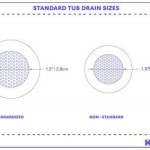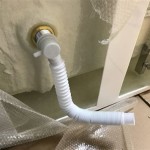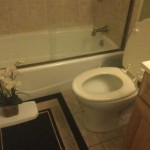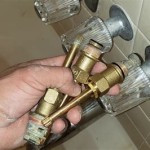Small Corner Bathtub Dimensions: A Comprehensive Guide
Space optimization is a crucial consideration in modern bathroom design. Small corner bathtubs present a practical solution for maximizing bathing comfort within limited spatial constraints. Understanding the various dimensions and configurations of these bathtubs is essential for successful planning and installation. This article provides a detailed exploration of small corner bathtub dimensions, focusing on key factors impacting their suitability in different bathroom layouts.
Understanding Basic Corner Bathtub Dimensions
Corner bathtubs, by definition, are designed to fit into the corner of a bathroom, typically against two walls. Their dimensions are categorized by length, width, and depth. For small corner bathtubs, which are the focus of this discussion, length and width are the most critical factors in determining their footprint within the bathroom. Depth plays a role in water capacity and user comfort but is less impactful on the overall space occupied. Common materials used in the manufacturing of corner bathtubs, such as acrylic, fiberglass, and cast iron, can also subtly affect the external dimensions due to varying wall thicknesses. Prioritizing accurate measurements and material considerations is paramount prior to purchase.
The dimensions of a small corner bathtub typically range from 48 inches to 60 inches in length and width. It's vital to measure the available space meticulously. This measurement should account not only for the bathtub itself but also for any surrounding features, such as walls, doors, and other bathroom fixtures. Consider the accessibility around the bathtub for cleaning and maintenance purposes.
While length and width delineate the horizontal footprint, the depth of the bathtub dictates its water capacity and the immersion level experienced by the user. Small corner bathtubs generally have depths ranging from 14 inches to 20 inches. Shallower depths are easier to access and may be preferable for individuals with mobility issues, while deeper depths offer a more immersive bathing experience. The slope of the interior walls also affects the usable depth and overall comfort.
It is also important to consider the “apron height”, which refers to the height of the finished side of the bathtub. This dimension impacts the overall aesthetic and ease of entry and exit. Standard apron heights usually fall between 20 and 24 inches. Carefully evaluate the combined effects of depth and apron height to establish optimal comfort and accessibility.
Key Considerations for Selecting the Right Size
Selecting the appropriate size of a small corner bathtub involves a comprehensive assessment of the bathroom's layout, plumbing configurations, and personal preferences. A thorough evaluation of these factors will contribute to a functional and aesthetically pleasing bathing space.
First, analyze the bathroom's layout. Create a detailed floor plan, accurately representing the positions of existing fixtures, doors, and windows. This plan should delineate the available corner space earmarked for the bathtub. Consider the swing of the bathroom door; ensure it does not impede access to the bathtub. Furthermore, factor in clearances for other fixtures such as the toilet, sink, and shower stall. Generally, a minimum of 30 inches of clear space is recommended in front of each fixture.
Second, investigate the existing plumbing configuration. Determine the location of the drain and water supply lines. Altering plumbing can be costly and time-consuming; therefore, selecting a bathtub that aligns with existing plumbing infrastructure can streamline the installation process. If plumbing modifications are unavoidable, obtain professional advice and accurate cost estimates before proceeding.
Third, consider the user's needs and preferences. Evaluate who will primarily use the bathtub and their bathing habits. A taller individual may require a longer bathtub for comfortable stretching, while someone with mobility limitations may benefit from a shallower depth and lower apron height. The desired bathing experience, whether a quick shower or a long, relaxing soak, should also inform the selection. Some models offer built-in features like jet systems or contoured backrests to enhance comfort.
Finally, research various bathtub models and their specifications. Manufacturers typically provide detailed dimension diagrams that include not only the overall length, width, and depth but also the interior dimensions and the placement of the drain. Cross-referencing these diagrams with the bathroom layout and plumbing configuration will help ensure compatibility and avoid potential installation issues.
### Exploring Different Small Corner Bathtub Shapes and StylesSmall corner bathtubs are available in a variety of shapes and styles, each designed to complement different bathroom aesthetics and provide unique bathing experiences. The most common shapes include triangular, pentagonal, and asymmetrical designs. The choice of shape significantly contributes to the visual appeal and functionality of the bathing area.
Triangular corner bathtubs are characterized by their symmetrical, 90-degree corner placement. These bathtubs typically have equal length and width dimensions along the walls, creating a balanced and space-efficient design. Triangular bathtubs are well-suited for smaller bathrooms where maximizing floor space is a priority. Their shape also provides a comfortable space for one bather.
Pentagonal corner bathtubs feature a five-sided design, with two sides adjoining the walls and three sides forming the outer curve. This shape offers a larger bathing area compared to triangular models, making them suitable for larger individuals or those who prefer more room to stretch out. Pentagonal bathtubs often feature a more stylish and contemporary look, enhancing the overall aesthetic of the bathroom.
Asymmetrical corner bathtubs are characterized by their irregular or non-symmetrical shape. These bathtubs can offer unique design opportunities, allowing for creative space utilization and distinctive bathroom layouts. Asymmetrical designs often feature variations in length and width, accommodating specific bathroom dimensions or incorporating design elements such as built-in seating or storage shelves. These models are particularly effective in bathrooms with unusual angles or limited space.
In addition to shape, the style of a small corner bathtub can significantly impact the overall bathroom design. Styles range from traditional to modern, with variations in apron design, faucet placement, and material finish. Traditional styles often feature decorative aprons and clawfoot designs, while modern styles typically showcase clean lines, minimalist aesthetics, and integrated faucet systems. The choice of style should complement the existing bathroom décor and reflect the user's personal preferences.
Furthermore, consider the material of the bathtub. Acrylic bathtubs are lightweight, durable, and easy to clean, making them a popular choice for many homeowners. Fiberglass bathtubs are more affordable but less durable than acrylic. Cast iron bathtubs offer superior heat retention and durability but are significantly heavier and more expensive. The material selected should align with the budget, desired durability, and the overall aesthetic of the bathroom.
Installation Considerations for Small Corner Bathtubs
Proper installation is crucial for the longevity and functionality of a small corner bathtub. This process involves careful planning, accurate measurements, and adherence to local plumbing and building codes. Incorrect installation can lead to leaks, structural damage, and safety hazards. Consulting a professional plumber is highly recommended, but understanding the key installation steps can help ensure a successful project.
Before starting the installation, ensure that the subfloor is level and structurally sound. A level subfloor is essential for proper bathtub support and prevents unnecessary stress on the bathtub's structure. If the subfloor is uneven, it must be leveled using shims or self-leveling compound before proceeding. Inspect the subfloor for any signs of water damage or rot, and address any issues before installing the bathtub.
Next, prepare the plumbing connections. Ensure that the drain and water supply lines are properly located and accessible. Connect the drain to the existing plumbing system using appropriate fittings and sealant. Install shut-off valves on the water supply lines to facilitate future maintenance and repairs. Test the drain and water supply lines for leaks before proceeding. Local plumbing codes dictate specific requirements for pipe materials, connections, and drain configurations; ensuring compliance is essential for a safe and compliant installation.
Carefully position the bathtub in the corner, ensuring it is level and aligned with the surrounding walls. Use shims to fine-tune the level as needed. Once the bathtub is properly positioned, secure it to the walls using screws or adhesive, following the manufacturer's instructions. Caulk around the perimeter of the bathtub where it meets the walls to create a watertight seal. This prevents water from seeping behind the bathtub and causing mold or water damage. Select a high-quality, mildew-resistant caulk for optimal protection.
Finally, install the faucet and other accessories. Follow the manufacturer's instructions for installing the faucet, showerhead, and any other desired features. Test all plumbing connections for leaks and ensure that the water flows properly. Clean the bathtub and surrounding area, and inspect the installation for any potential issues. A thorough inspection ensures that all components function as intended and the installation meets all safety and aesthetic requirements.

Acrilan Mykonos Modern Acrylic White Gloss Small Corner Bath Tub 90x90 Cm Flobali
G7888 Credo Corner Bathtub 140x140cm Bathing

Corner Acrylic Bathtub Flora Neo 120 Cm

Del Rey Small Walk In Tub 38 X Inch Corner Bathtub Boundless Bath

Pin Page

All S
.jpg?strip=all)
ᐈ Aquatica Olivia Wht Small Corner Acrylic Bathtub Buy Best S

Corner Tubs For Small Bathrooms Visualhunt
.jpg?strip=all)
ᐈ Aquatica Idea L Wht Corner Acrylic Bathtub Buy Best S

Aquatica Olivia Bath Corner Skirted Soaking Tub
Related Posts








